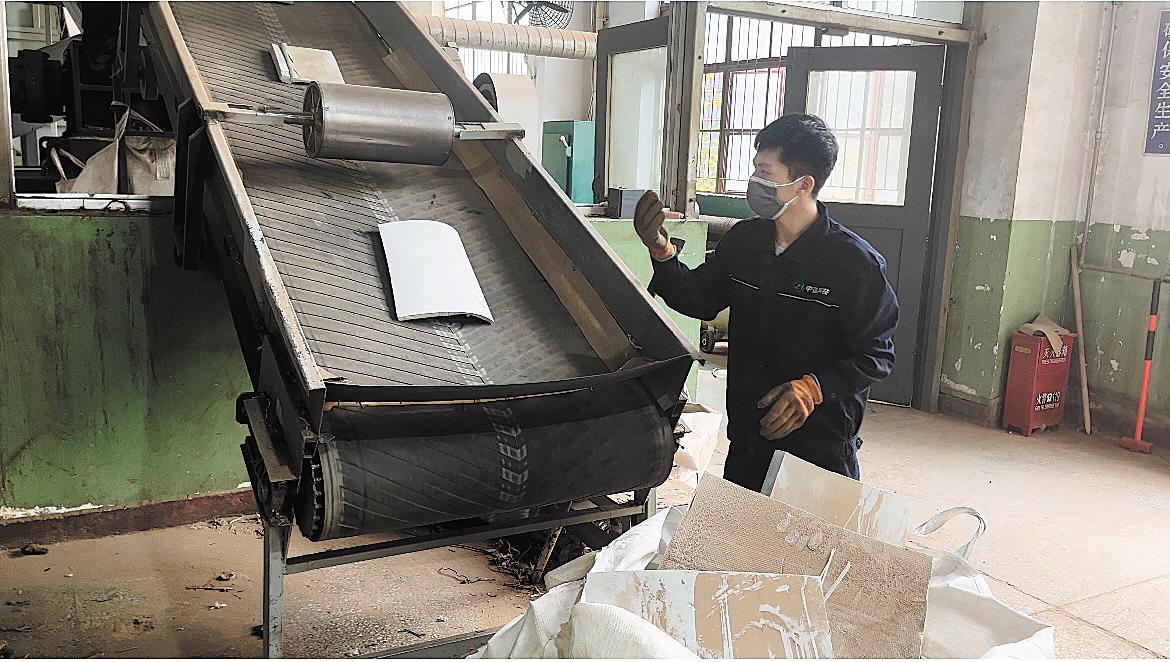Editor's note: China Daily is publishing a series illustrating the country's efforts to achieve its carbon peak and carbon neutrality goals.

Materials from a decommissioned wind turbine are processed for recycling at a factory in Yinchuan, Ningxia Hui autonomous region. CHINA DAILY
With a designed life span of roughly 20 to 25 years, many wind turbines in China are on the cusp of being decommissioned and replaced with newer, more powerful and more efficient models. However, the question of what to do with these retired power generators in a green and sustainable way remains a challenge.
In Yinchuan, capital of Northwest China's Ningxia Hui autonomous region, a groundbreaking production line is transforming decommissioned wind turbine blades into robust products, tackling the global challenge, promoting the circular economy and driving economic growth.
The facility, employing a physical process that involves crushing turbine blades before compacting them into logistics pallets and building formwork is set to be fully operational by the end of the year, and will be able to recycle 30,000 metric tons of turbine blades annually.
The project, launched by Ningxia Zhonghong New Materials Technology, has attracted 100 million yuan ($13.6 million) in investment, with 30 percent allocated to the initial phase, said Ma Yuhu, general manager of the company.
Launched last year in alignment with the national strategy to enhance the circular economy and to combat the escalating recycling demands posed by the rapid expansion of wind energy, the project will play a pivotal role in addressing these pressing industry challenges.
"After being decommissioned, turbine blades, crucial components of wind energy equipment, pose a management challenge due to their substantial size and distinctive materials," he said.
Turbine blades, ranging in length from 50 to over 100 meters, are typically made from composite materials such as fiberglass and carbon fiber, which are strong and lightweight. The complex composition of these materials makes it challenging to separate and recycle them effectively.
Ma said that in Europe and the United States, most blades are disposed of via landfill, incineration, or extended storage, resulting in notable negative environmental impacts.
"China is also beginning to grapple with similar issues," he said.
China began promoting large-scale wind energy development around the new millennium, so many turbines are coming up to retirement, he added.
According to the Chinese Wind Energy Association, the installed capacity of decommissioned wind turbines nationwide reached about 100,000 kilowatts in 2023, and is projected to increase to 500,000 kilowatts this year.
By 2030, wind turbines capable of generating a total of 44.7 million kilowatts will have reached the end of their operational life, resulting in 947,900 tons of potential solid waste.
Ma explained that after more than a year of efforts to analyze the composition of materials and conduct extensive experiments, his company determined that decommissioned wind turbine blades could be repurposed as raw materials for various products.
He highlighted that by harnessing the expertise of domestic research institutes specializing in new materials and drawing on its own innovative research, the company developed a patented technology to convert retired wind turbine blades into products such as pallets and building formwork.
Tests show that these products demonstrate strong load-bearing capacity, and excellent waterproofing and weather resistance, transforming retired wind turbine blades from waste into treasure, the general manager said.
"A key challenge we currently face is the insufficient volume of retired blades, which falls short of meeting our production demands, resulting in low output and overall profits that are less than satisfactory," he said.
The company's production line features an advanced dust removal system to minimize environmental impacts, Ma said, adding that no wastewater is generated throughout the entire production process.
"This technological breakthrough has not only addressed challenges in processing retired wind turbine blades, but also paved the way for new economic growth opportunities for businesses," he added.
According to the Ningxia Development and Reform Commission, the installed capacity of wind power in the region is about 15.1 million kilowatts, almost 3 percent of which has been in service for more than 20 years.
Emphasizing the increasing urgency, the demand for recycling wind and solar power generation facilities in Ningxia and across Northwest China will intensify as the service life of these facilities lengthens, it said, responding to questions from China Daily.
This trend is particularly pronounced due to the substantial deployment of renewable energy facilities in the region, it said.
Ma said his company, as planned when it was established, will not only target retired turbine blades in Ningxia, but also its neighboring regions of the Inner Mongolia and Xinjiang Uygur autonomous regions and Gansu province, all of which are major wind power generators.
"With the upgrading of wind power generation technologies and facilities, a large amount of decommissioned wind turbine blades will be generated in these regions," Ma said.
Contact the writers at houliqiang@chinadaily.com.cn